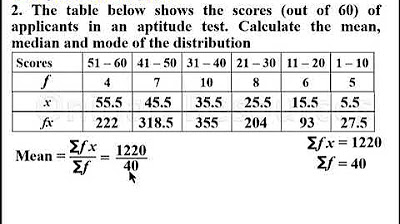Impact on median and mean when removing lowest value example | 6th grade | Khan Academy
TLDRThe video script discusses the impact of removing an outlier score on the mean and median of a data set. Ana, a golfer, had her lowest score of 80 disqualified due to rule violations. Initially, with five rounds played, the median score was 92. After the disqualification, the median rose to 93, calculated as the average of the two middle scores, 92 and 94. The mean also increased, moving from 90.4 (90 and 2/5) to 93, after the removal of the lowest score. The video illustrates that both the mean and median increased with the removal of the lowest score, but the mean increased by a greater amount, demonstrating the sensitivity of the mean to outliers.
Takeaways
- 🏌️ Ana played five rounds of golf with her lowest score being an 80.
- 📊 The dot plot shows scores from the first four rounds and the lowest round, which was an 80.
- ❌ Ana cheated during the round where she scored 80, so that score was removed from the data set.
- 🔢 With five data points, the median was 92, but after removing the lowest score, the median increased to 93.
- 📈 The removal of the lowest data point (80) increased the median by one point.
- 🧮 The mean of the five rounds was calculated to be 90 and 2/5 (or 90.4).
- 📉 Upon removing the lowest score, the mean increased from 90.4 to 93, a larger increase than the median.
- 🔑 Removing a score lower than the mean will cause the mean to increase.
- 🔄 The mean increased by more than the median because the removed score was significantly lower than the others.
- 🤔 The intuition behind the change in mean and median is that removing a lower score raises the average, while the median is less affected due to its position in the ordered set.
- ✅ The correct conclusion from the analysis is that both the mean and the median increased, but the mean increased by more than the median.
Q & A
What was Ana's lowest golf score before the cheating incident?
-Ana's lowest golf score before the cheating incident was an 80.
How many rounds of golf did Ana play before the score of 80 was removed?
-Ana played five rounds of golf before the score of 80 was removed.
What were the scores of the other four rounds besides the lowest round of 80?
-The scores of the other four rounds were 90, 92, 94, and 96.
What is the median score of Ana's golf rounds before the removal of the 80?
-The median score before the removal of the 80 is 92, as it is the middle score when the scores are listed in order.
What is the median score of Ana's golf rounds after the removal of the 80?
-The median score after the removal of the 80 is 93, which is the average of the two middle scores (92 and 94) when the scores are listed in order.
What is the mean score of Ana's golf rounds before the removal of the 80?
-The mean score before the removal of the 80 is 90 and 2/5 (or 90.4), calculated by summing all the scores and dividing by the number of rounds (5).
What is the mean score of Ana's golf rounds after the removal of the 80?
-The mean score after the removal of the 80 is 93, calculated by summing the remaining scores and dividing by the new number of rounds (4).
How does the removal of the lowest score affect the median?
-The removal of the lowest score increases the median from 92 to 93, as the middle values shift upward with the removal of the lower score.
How does the removal of the lowest score affect the mean?
-The removal of the lowest score causes the mean to increase from 90 and 2/5 (or 90.4) to 93, as the average is pulled up without the influence of the lower score.
Which measure increased more after the removal of the lowest score, the mean or the median?
-The mean increased more than the median after the removal of the lowest score. The mean went up by approximately 2.6 (from 90.4 to 93), while the median increased by 1.
Why does removing a score lower than the mean increase the mean?
-Removing a score lower than the mean increases the mean because the average is calculated by dividing the sum of all scores by the number of scores. When a lower score is removed, the sum increases at a slower rate than the number of scores decreases, thus raising the average.
What is the intuition behind the effect of removing a score on the mean?
-The intuition is that if you remove a score that is lower than the mean, you are eliminating a score that was pulling the average down. Consequently, the remaining scores, which are on average higher, will result in an increased mean.
Outlines
🏌️♀️ Ana's Golf Scores and Data Impact
The video discusses the impact of removing Ana's lowest golf score from her dataset. Initially, Ana's scores were 80, 90, 92, 94, and 96, with the lowest score of 80 being an instance of cheating and thus removed. The median of the original five scores was 92, but with the removal of the 80, the median increased to 93, calculated as the average of the two middle scores, 92 and 94. The mean of the original scores was 90 and 2/5, but after the removal, it increased to 93, as removing a score lower than the mean raises the overall average. The video emphasizes that both the median and mean increased, but the mean rose by a greater amount due to the significant difference between the removed score and the others.
📊 Analysis of Mean and Median Changes
This paragraph confirms the intuitive understanding that both the mean and median will increase when a score lower than the mean is removed from a dataset. Specifically, the mean increased from 90.4 to 93, and the median increased from 92 to 93. The video concludes that the correct answer to the question of how the removal of the lowest score affects the mean and median is that both increase, with the mean increasing by more than the median, which is consistent with the observed data changes.
Mindmap
Keywords
💡Golf Rounds
💡Lowest Score
💡Dot Plot
💡Median
💡Mean
💡Cheating
💡Data Set
💡Central Tendency
💡Removal of Data
💡Statistical Analysis
💡Intuition
Highlights
Ana played five rounds of golf with her lowest score being an 80.
A dot plot displays the scores of the first four rounds and the lowest round.
Ana's scores were 80, 90, 92, 94, and 96.
Ana's score of 80 was discovered to be a result of cheating and was removed from the data set.
After removing the lowest score, the remaining scores are 90, 92, 94, and 96.
The median score with five data points was 92.
The median score with four data points is calculated as the average of the two middle numbers, 92 and 94, resulting in 93.
The removal of the lowest score increased the median from 92 to 93.
The mean of the five scores was calculated to be 90 and 2/5.
Removing the lowest score causes the mean to increase because the removed score was lower than the existing mean.
The mean of the four remaining scores is calculated to be 93.
The mean increased by more than the median after the removal of the lowest score.
The mean went from 90 and 2/5 (90.4) to 93 after the removal of the lowest score.
The median and mean both increased, but the mean's increase was more significant.
The intuition behind the mean increase is that removing a score lower than the mean raises the average.
The mathematical verification of the mean increase confirms the initial intuition.
The correct answer is that both the mean and the median will increase, with the mean increasing more than the median.
Transcripts
Browse More Related Video

Impact on median and mean when increasing highest value | 6th grade | Khan Academy

Mean, Median and Mode - Measures of Central Tendency

The Maths Prof: Frequency Tables (Mean, Median, Mode & Range)

Simple explanation of Modified Z Score | Modified Z Score to detect outliers with python code

Estimating mean and median in data displays | AP Statistics | Khan Academy

Mean, Median and Mode of Grouped Data(Lesson 2)
5.0 / 5 (0 votes)
Thanks for rating: